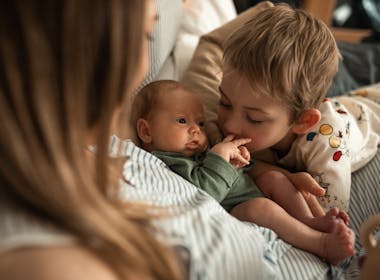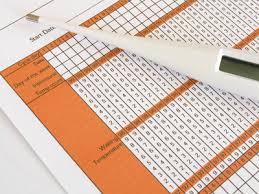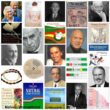Back in college, I heard a lecture on why breastfeeding is better. The facts convinced me. I made a mental note for the future. It was the only time I remember ever hearing that message. Years later when I had my first baby and had occasion to use the information, I remembered that lecture and my decision.
So I breastfed my kids. I had more to learn then about how to actually succeed at it. I had to develop some expertise at it and invest some time and effort to make it work. But ever since then, I’ve continued to learn what a good decision it was.
I even saw an ad on the back of a bus recently encouraging women to breastfeed because of the multitude of proven health benefits to the baby and to the mom. The public is investing money and effort in communicating the importance of breastfeeding. I applaud that move. I’ve always been glad that I was informed. If I hadn’t heard that one lecture, I might be hearing all these positive messages now with regret that it was too late and no one had told me back then.
When you learn the occasional thing that’s relevant to you in school, it can stick with you for life.
So how can we bring more of this kind of practical, beneficial information to young girls today? A few weeks ago, I wrote about how sex ed as we teach it is basically selling contraceptives and gender ideology, but not the useful, valuable knowledge of their bodies that girls could be getting. Learning fertility charting is the best way I know of to turn girls into experts on their own bodies.
But a question remains: doesn’t the existence of effective contraceptives simplify all our lives by making biological understanding unnecessary? Why would women need to know when they ovulate if we can just suppress ovulation with a pill or a shot?
Fertility charting comes with a whole range of benefits that contraceptives lack.
Fertility charting gives women real information
If we are teaching kids anything about sex, shouldn’t we start with real knowledge about their bodies? Not information about products they should buy to manage their bodies, but the real goods on their bodies: what ovulation is and when it happens, the process of conception, the role of the uterus and of the cervix, the cervical mucus itself (which girls regularly confuse with an infection), what periods are, etc.. Kids are a captive audience, with much of their time dedicated to nothing but learning. So why squander the time teaching them how not to have to think about their biology by becoming ignorant consumers of products? More information is definitely better than less here.
The media and medical sources consistently and inaccurately discredit fertility awareness methods as having a 25% failure rate, which is the failure rate of the rudimentary old Rhythm Method. Getting the public up-to-date with accurate information is the first step.
Fertility charting gives girls more options
Women are under-informed about their bodies but even more under-informed about their natural options for avoiding or achieving pregnancy and for knowing their bodies. Young women are capable of making good decisions when they are given the facts and given all their options. Let’s let them truly choose, based on real understanding of the body and a true picture of the options. Girls need to know the truth. They should be told the real risks of sexually transmitted diseases as well as the emotional consequences of sexual activity. They need to know both that contraceptives come with serious risks, especially for certain women, and that there are effective natural options.
Fertility charting gives women practical tools
Fertility charting provides girls both real knowledge and real life skills that serve them for planning pregnancies and in taking care of their health. Furthermore, girls can practice it and benefit from it right away, whether or not they are already sexually active. When our 21-year-old daughter had her first sessions in learning to chart, she came home and mentioned, “I think I’m low in progesterone.” What valuable data! Some of the problems she was having were traceable to low hormone levels, which can be treated precisely. Instead of putting all girls in an assembly line of taking the Pill for every disorder, charting brings forth the specific data needed to uncover what’s really wrong and treat it more effectively. Fertility charting brings true health literacy to both doctors and patients.
Fertility charting is not hard
Fertility charting can be learned in three hours of instruction, combined with a minute or two per day on your own of taking note of an observable sign or two (cervical mucus, temperature are the main ones) that the body naturally produces. Sure, it makes demands on anybody who learns it, but kids don’t need to be spared the bother of having to know anything. Kids want to know things. They like being fully informed instead of being fed only the part of the story we want them to hear. They like gaining mastery and self-sufficiency. They respond to stimulating ideas and information on reality that affects them. They respond to respect. Fertility charting education meets all these needs.
Fertility charting saves lives
A certain amount of risk of pregnancy always comes with sex, with any and all methods to avoid it, including fertility charting methods. Contrary to popular opinion, however, effectiveness in preventing pregnancy with fertility charting methods is just as high as with contraceptives. So on that point they’re about neck-and-neck.
Fertility charting methods of avoiding pregnancy zoom ahead in the comparison with contraceptives on the health risks and side effects. Breastfeeding is now promoted because, among many other reasons, it protects women from cancer. Certain contraceptives greatly increase the risk of breast cancer. Fertility charting does no such thing.
Why do we as a society choose to remain ignorant about fertility charting? Because we are afraid to trust young girls to be responsible for their own bodies? Because it’s unfamiliar and change is hard? Because nobody but women stand to benefit from such a change?
How can we get fertility charting into high school curricula? Public demand in significant numbers can be effective. I made a suggestion to the principle of my daughter’s high school after she graduated. I got no response, and I don’t think anything came of one mom of a former student making the suggestion. At least I did what I could. But what if 200 parents had made the same request? Even if three or four made the request, every year, we might get the attention of those in charge. If we all speak up, we will eventually be heard.
So let’s speak out for fertility education just as we speak for breastfeeding education. Share the truth to help spare young girls the regret of not knowing.
Resources for teen fertility awareness education
The Couple to Couple League realizes that mothers are in a special position to engage their daughters about the gift of their fertility. Their Mother / Daughter program lets you choose the resources you feel would be the best to communicate with your daughter about fertility awareness.
Teen STAR is a developmental curriculum founded by Hanna Klaus, MD (Sr. Miriam Paul , MMS) that helps adolescents and young adults to come to terms with their emerging sexuality and fertility and assist them in making responsible decisions.
The Cycle Show is an educational, interactive, multi-media, fertility awareness workshop for young girls.
The FEMM App helps girls understand their reproductive health in all its physical and emotional complexity.







